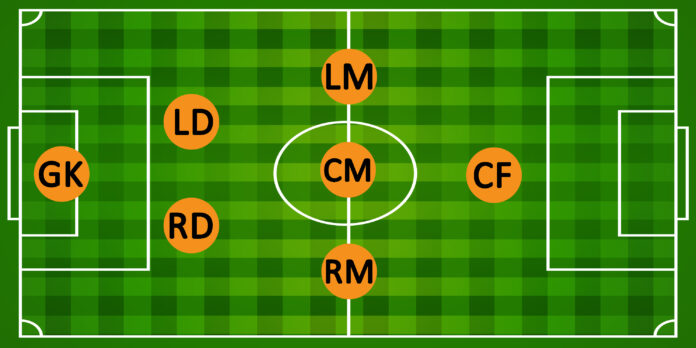7v7 soccer is a fast-paced format for young players, aged 8 to 10. It is a key stage in their development. This format lets players refine their skills and teamwork. It is more complex than 5v5, but less so than 9v9 or 11v11. When it comes to 7v7 soccer formations, it’s vital to prioritize player development over tactical rigidity. The formation should boost learning and growth, not dictate play.
This guide will explore several effective 7v7 soccer formations. They will help develop skills and prepare players for more advanced formats. You can choose the best formation for your team. It should align with their needs and create a fun, productive learning space. Let’s explore these formations.
Formation 2-3-1
The 2-3-1 formation is a popular choice in 7v7 soccer. It offers a good balance between defense and midfield control. This formation consists of two defenders, three midfielders, and one forward. The structure is good for teams that want to control the midfield while ensuring a strong defense.
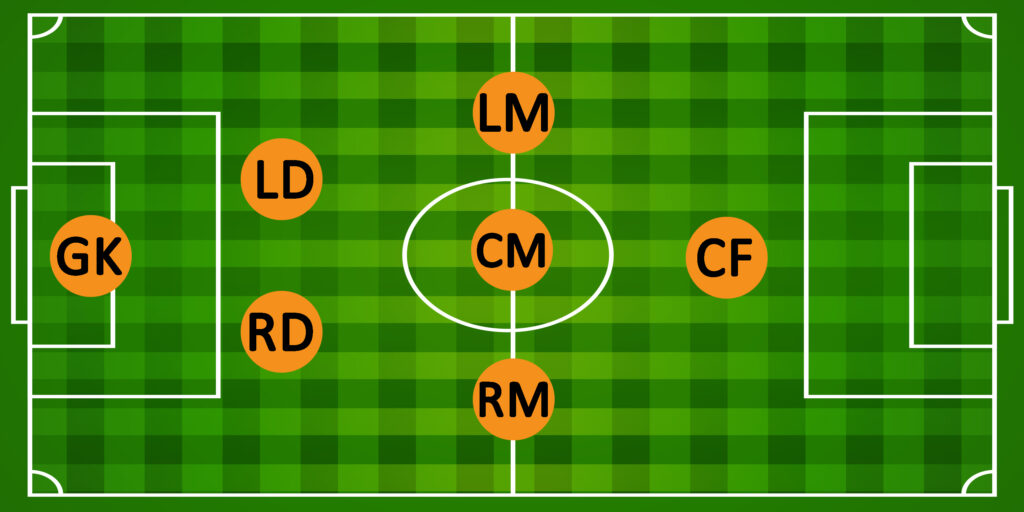
Pros:
- Balanced Midfield Control: Three midfielders let the team control the center of the pitch. They can dictate the game’s pace and transition smoothly between defense and attack.
- Flexible Defense: The two defenders form a strong backline. The central midfielder can drop back to help with defense when needed, adding support against attacks.
- Support for the Forward: The midfielders support the lone forward. They can pass and create scoring chances.
Cons:
- Vulnerable Flanks: With only two defenders, the team is exposed to wing attacks. Opponents with fast wingers or wide-play strategies can exploit these areas.
- Dependence on Midfielders: This formation relies on the midfielders. They must cover both defensive and offensive roles. They must be disciplined and work well together. This prevents gaps and creates scoring chances.
Transition from 2-3-1 to 9v9 Formations:
- 3-3-2: Switching to a 3-3-2 formation adds an extra defender. It improves defense while keeping midfield strength.
- 3-2-3: By adding a forward, the team can increase offensive pressure and options. This will shift them to a more attack-focused 9v9 formation.
Formation 3-2-1
The 3-2-1 formation is one of the best choice from all 7v7 soccer formations. It has a strong defense and a balanced midfield. This formation consists of three defenders, two midfielders, and one forward. It is great for teams with a strong defense and quick counter-attacks.
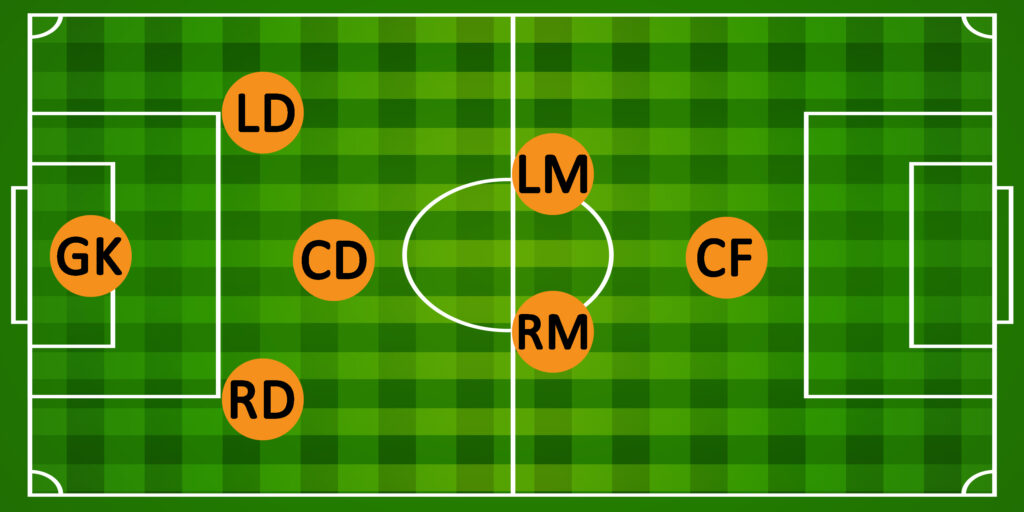
Pros:
- Strong Defensive Line: The team has three defenders. They form a solid backline that can counter attacks and stabilize the defensive third.
- Midfield Support: The two midfielders can control the center of the pitch. They must support both defense and attack. This will ensure a smooth transition between phases of play.
- Focused Attack: The midfielders support the forward. They can pass and create scoring chances.
Cons:
- Limited Attack Options: With only one forward, the team may need help to break down strong defenses. The midfielders must contribute to the attack to make up for the lack of forward options.
- Dependence on Midfielders: This formation relies on the midfielders. They must connect the defense and attack. They need to be versatile and disciplined to cover all necessary roles.
Transition from 3-2-1 to 9v9 Formations:
- 4-3-1: Adding an extra defender changes the formation to a 4-3-1. It makes the defense stronger and helps the midfield.
- 3-4-1: With an extra midfielder, the team can shift to a 3-4-1 formation. This boosts midfield control and creates more attacking chances.
Formation 3-1-2
The 3-1-2 formation is a versatile choice among 7v7 soccer formations. It stresses on a strong defense and a lively midfield. This formation includes three defenders, one midfielder, and two forwards. It is great for teams that want a strong defense and a powerful attack.
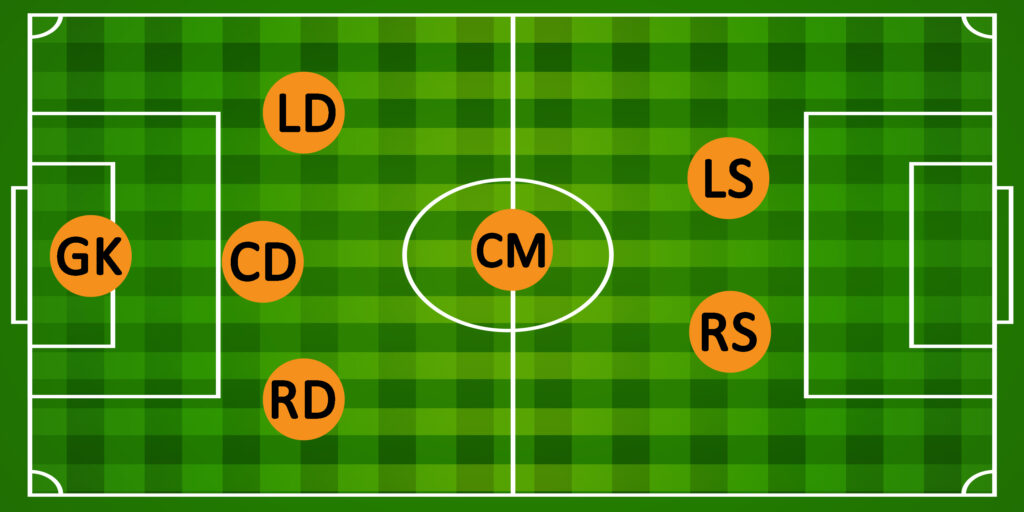
Pros:
- Strong Defensive Base: The three defenders form a strong backline. They thwart opponents’ attacks and provide solid defense.
- Increased Attacking Options: With two forwards, the team can pressure the opponent’s defense. This creates more scoring chances.
- Flexible Midfield Support: The single midfielder links defense and attack. They support both the forwards and the defense.
Cons:
- Midfield Vulnerability: With just one midfielder, the team may struggle to control the center of the pitch. They may be vulnerable to attacks in the midfield.
- Over-reliance on Forwards: This formation relies on the forwards to score. If they are not supported well, the team might find it difficult to score.
Transition from 3-1-2 to 9v9 Formations:
- 4-3-1: Adding an extra defender and midfielder can switch the formation to a 4-3-1. This improves defense, midfield control, and support for the forwards.
- 3-4-2: Adding a midfielder and a forward would shift the team to a 3-4-2 formation. This would boost midfield control and attack options.
Formation 4-1-1
The 4-1-1 is a defensive option from 7v7 soccer formations. It emphasizes a strong backline and a solid midfielder. This formation consists of four defenders, one midfielder, and one forward. It is ideal for teams with a strong defense and some attack.
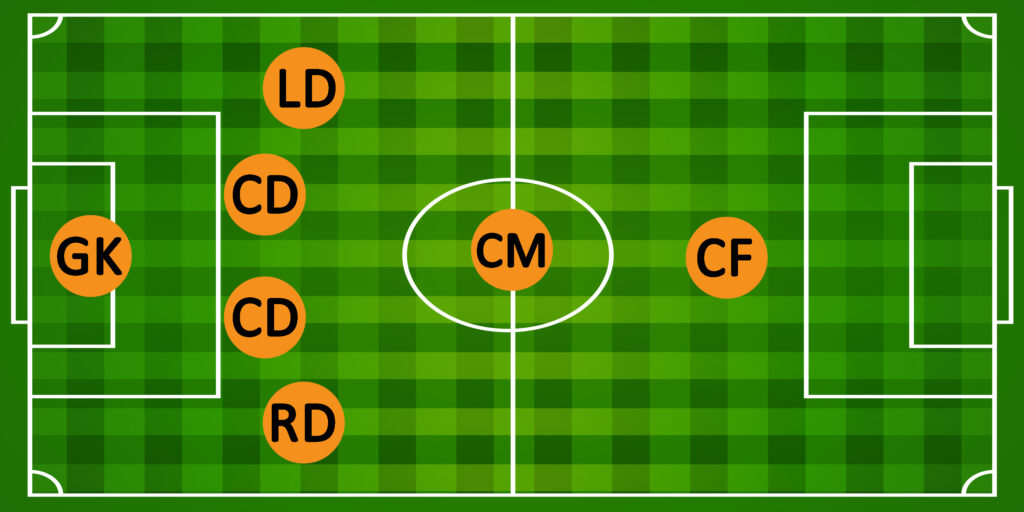
Pros:
- Robust Defense: The team has a strong, secure backline with four defenders. It can handle opposing attacks and cover the defensive third.
- Midfield Stability: The single midfielder links defense and attack. They help distribute the ball and support both defensive and offensive plays.
- Solid Defense: The extra defender makes it hard for opponents to break through.
Cons:
- Limited Attacking Power: The team has only one forward. It may struggle to create and take scoring chances. The forward may become isolated if not supported adequately.
- Midfield Isolation: With only one midfielder, the team may struggle to control the midfield. This could create gaps for opponents to exploit.
Transition from 4-1-1 to 9v9 Formations:
- 4-4-1: Adding an extra midfielder shifts the formation to a 4-4-1. It improves midfield control and supports the forward better.
- 4-2-1: The team can shift to a 4-2-1 setup by adding a midfielder and adjusting the formation. This will improve midfield stability and boost attack options.
Formation 1-4-1
The 1-4-1 formation is another strategic option in 7v7 soccer formations. It is defensive and midfield-oriented. This formation aims for midfield control and a strong defense. It suits teams that focus on possession and counter-attacks.
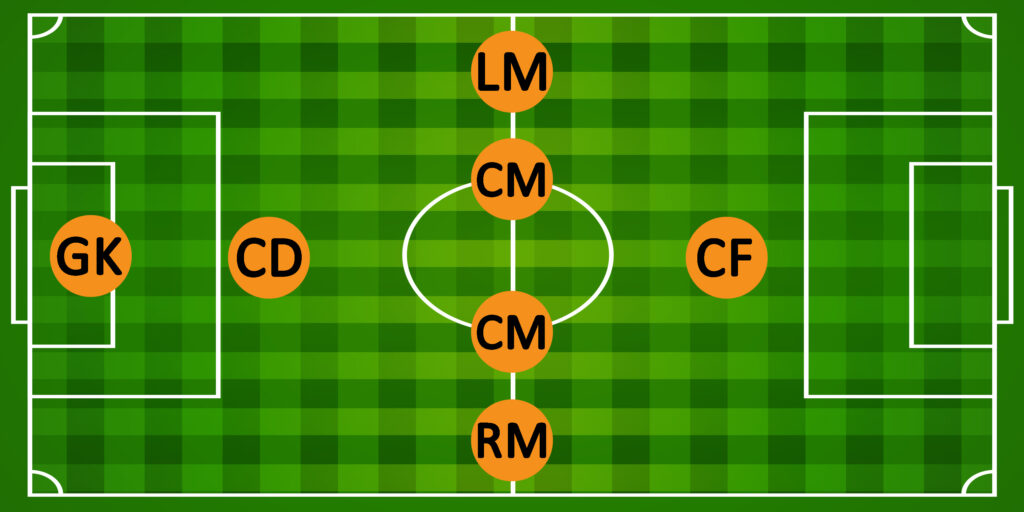
Pros:
- Midfield Dominance: Four midfielders let the team control the center of the pitch. They can set the game’s tempo and support both defense and offense.
- Flexible Defense: The single defender can focus on specific tasks. The midfielders can help defend if needed. This is less traditional coverage.
- Support for the Forward: The lone forward relies on the midfielders. They create scoring chances and make key passes.
Cons:
- Vulnerable Defense: The team may be exposed to direct attacks with only one dedicated defender. They could struggle against teams with strong attackers.
- Overreliance on Midfielders: This formation depends on the midfielders. They must cover both defensive and offensive roles. They must be disciplined and able to support the lone defender and forward.
Transition from 1-4-1 to 9v9 Formations:
- 4-4-1: Adding an extra defender changes the formation to a 4-4-1. It provides better defense while keeping midfield control.
- 3-4-1: The team can shift to a 3-4-1 formation by adding a defender and a midfielder. This will improve defense and midfield play.
Conclusion
It’s crucial to understand 7v7 soccer formations. They can improve a team’s performance and help players grow. Each formation has unique pros and cons. They affect a team’s control of the game, defense, and scoring chances. Coaches must know the strengths and weaknesses of formations like 2-3-1, 3-2-1, 3-1-2, 4-1-1, and 1-4-1. This helps them tailor strategies to their team’s needs. It also ensures smooth transitions to more complex formats, like 9v9.
By focusing on both formation and player development, teams can improve their gameplay. They can also prepare young players for future soccer challenges. 7v7 is a key stage in player growth. The insights gained from it will help in adapting to larger team formats. This will ensure players are ready for their soccer journeys ahead.







